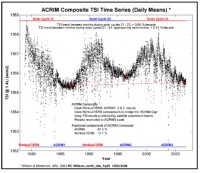By Roger Pielke Sr., Climate Science
At the December 2008 NRC meeting “Detection and Attribution of Solar Forcing on Climate” [see] there was extensive criticism by Gavin Schmidt and others on the research of Nicola Scafetta with respect to solar climate forcings. He was not, however, invited to that December meeting.
There is now a new paper that he has published that needs to be refuted or supported by other peer reviewed literature (rather than comments in a closed NRC meeting in which the presentors would not share their powerpoint talks).
The new paper is “Scafetta N., R. C. Willson (2009), ACRIM-gap and TSI trend issue resolved using a surface magnetic flux TSI proxy model, Geophys. Res. Lett., 36, L05701, doi:10.1029/2008GL036307”
The abstract reads:
“The ACRIM-gap (1989.5-1991.75) continuity dilemma for satellite TSI observations is resolved by bridging the satellite TSI monitoring gap between ACRIM1 and ACRIM2 results with TSI derived from Krivova et al.’s (2007) proxy model based on variations of the surface distribution of solar magnetic flux. ‘Mixed’ versions of ACRIM and PMOD TSI composites are constructed with their compositesí original values except for the ACRIM gap, where Krivova modeled TSI is used to connect ACRIM1 and ACRIM2 results. Both ‘mixed’ composites demonstrate a significant TSI increase of 0.033%/decade between the solar activity minima of 1986 and 1996, comparable to the 0.037% found in the ACRIM composite. The finding supports the contention of Willson (1997) that the ERBS/ERBE results are flawed by uncorrected degradation during the ACRIM gap and refutes the Nimbus7/ERB ACRIM gap adjustment Frohlich and Lean (1998) employed in constructing the PMOD.”
A key statement in the conclusion reads:
“This finding has evident repercussions for climate change and solar physics. Increasing TSI between 1980 and 2000 could have contributed significantly to global warming during the last three decades [Scafetta and West, 2007, 2008]. Current climate models [Intergovernmental Panel on Climate Change, 2007] have assumed that the TSI did not vary significantly during the last 30 years and have therefore underestimated the solar contribution and overestimated the anthropogenic contribution to global warming.” See post here.

Earlier Dr. Richard Willson reconstruction of the TSI filling the gap between the two ACRIM1 and ACRIM2 results using Nimbus7 ERB. See larger image here. Process was described in this ICECAP paper.

See decline of the TSI since 2003 in this extended solar minimum above. See larger image here.


